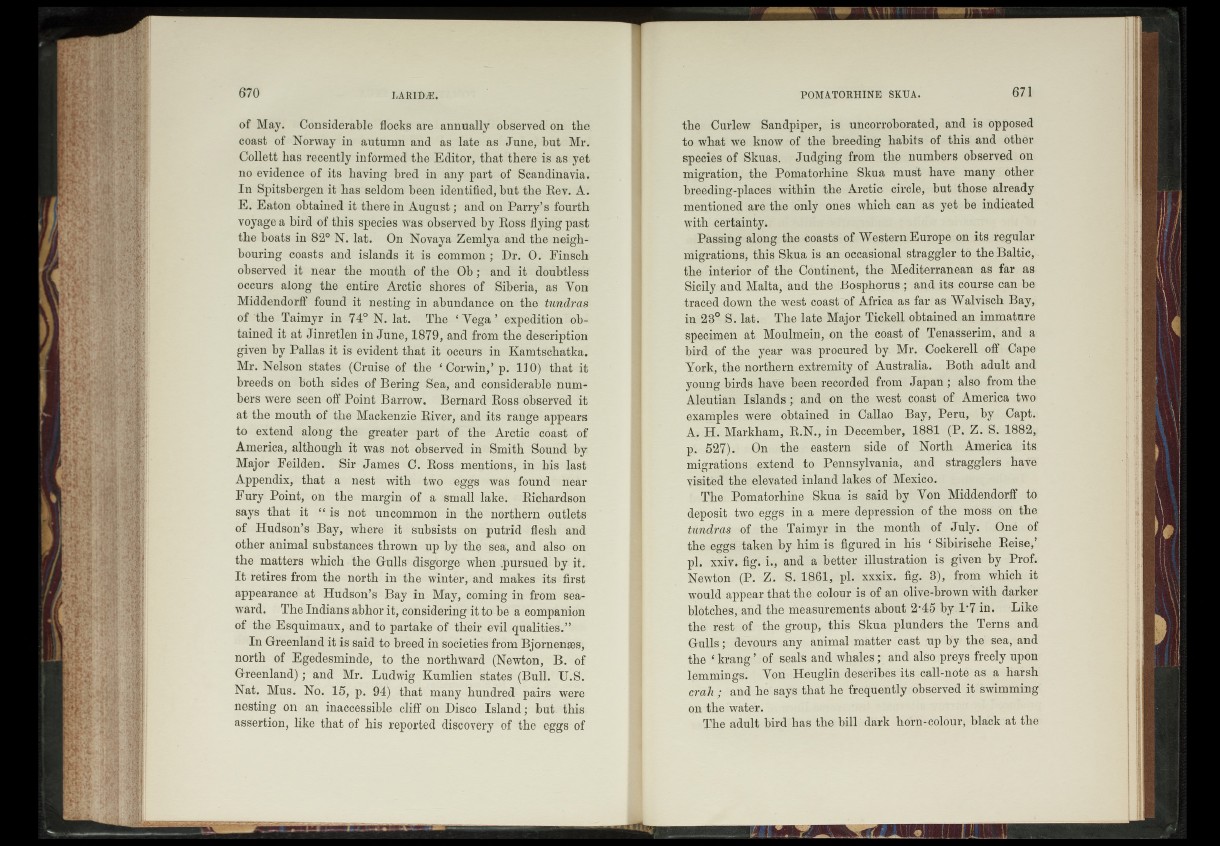
of May. Considerable flocks are annually observed on the
coast of Norway in autumn and as late as June, but Mr.
Collett has recently informed the Editor, that there is as yet
no evidence of its having bred in any part of Scandinavia.
In Spitsbergen it has seldom been identified, but the Rev. A.
E. Eaton obtained it therein August ; and on Parry’s fourth
voyage a bird of this species was observed by Ros? flying past
the boats in 82® N. lat. On Novaya Zemlya and the neighbouring
coasts and islands it is common; Dr. 0. Mnsch
observed it near the mouth of. the Ob; and it doubtless
occurs along the entire Arctic shores óf Siberia, as Yon
Middendorff found it nesting in abundance on the tundras
of'the Taimyr in 74° N. lat. The £ Vega | expedition 'ob-i.
tained it at Jinretlen in June, 1879, and -from the description
given by Pallas it is evident that it occurs in Kamtschatka.
Mr. Nelson states (Cruise of the -^Corwin,* p. 110) that it
breeds on both sides of Bering Sea, and considerable num-.
bers were seen off Point Barrow. Bernard Boss observed it
at the mouth of the Mackenzie Biver, and its range appears
to extend along the greater part of the' Arctic coast of
America, although it was not observed in Smith Sound' by
Major Feilden. Sir James Ci. Boss mentions, in his last
Appendix, that a nest with two eggs ■ waè found near
Fury Point, on the. margin of a small lake. Bichardson
says that it “ is not uncommon in thé f northern outlets
of Hudson’s Bay, where! it subsists on putrid flesh and
other animal substances thrown up-fej&the sea, and al'so^ on
the matters which • the Gulls disgorge when .pursued by it#.
It retires fromthenorth in the winter; and makes- its-first
appearance at Hudson’s Bay in May, comingdn- from seaward.
The Indians abhor it, consideringit to;be a companion
of the Esquimaux, and to partake of their evil-qualities,”'
In Greenland it is said to breed in sóèiéties from Bjornenaes;
north of Egedesminde, to the northward (Newton, B. of
Greenland); and Mr. Ludwig Kumlien states (Bull. U.S.
Nat. Mus. No. 15, p. 94) that many hundred pairs were
nesting on an inaccessible; cliff on Disco Island; bub this
assertion, like that of his reported discovery^of the eggs'of
the Curlew Sandpiper, is uncorroborated, and is opposed
to what we know of the breeding habits of this! and other
species of Skuas. Judging from the numbers observed on
migration, the Pomatorhine Skua must have many other
breeding-places within the Arctic circle, but those already
mentioned are the only ones which can as yet be indicated
with certainty.
Passing along the coasts of Western Europe on its regular
migrations; this Skua is an occasional straggler to the Baltic/ -
the interior of the'Continent; the Mediterranean as far as
SiGily and:Malta, andjthe Bosphorus; and its course can be
traced down the west coasfof Africa as far as Walvisch Bay,
in $8° .8. lat. i The late Major Tickell obtained an immature
specimen at Moulmein, on the coast of Tenasserim, and a
bird of the year' was; procured by. Mr. Cockerell off Cape;
York, the northern extremity of Australia. Both adult and
y@ung birds have been recorded from Japan ; also from the
Alelstfan Islands ; and <#h the.:we,st eoasbrnf; America twdt
examples :were: obtained in Callao Bay, Peru, by Capt,*
A. H. Markham, B.N»;-in December, 1881||$feJ^‘lS. 1882*
p. 527}i r On? the. eastern.? side of North/ America its.
migration „ extend' to Pennsylvania, and stragglers hate
yisit’ed the-elevated inland'lakes of Mexico,.
' The Pomatorhine Skua* is said by Yon Middendorff to.
deposit twoLeggs: in a mere depressioh/of the moss bn the
tundras. >ofr4%e Taimyr in the month of Julyi One off
the -eggs taken by him is figured in his ^Sibirisehe Beise,’
pi. xxiv. fi'gi i., and a better illustration is given by Prof*
Newton (P»?Zv S. 1861, pl.,xxxix;^&g*|§j|» which.iff
would appear that the colour is of an oliverbro.wn with darker
blotches, and/the measurements about 2~%45 by.l*7 in. Like
the test of the-grbupM this, Skua plunders then Terns and;
Gulls;- devours any animal matter- cast up by/ the sea, and
the £ krangoff seals and whales; and also preys freely upon
lemmingshf^YomfHeuglih- describes its call-note as a harsh
craft ; and he'says-that the frequently observed it swimming
on the lwateff. Sj
The adultibird has the bill dark hornscdjtaur, black-at the